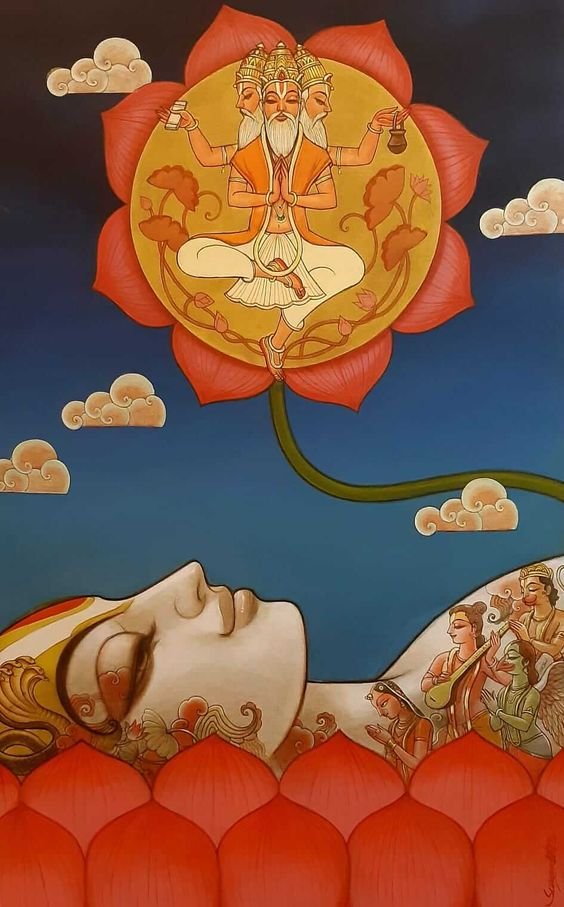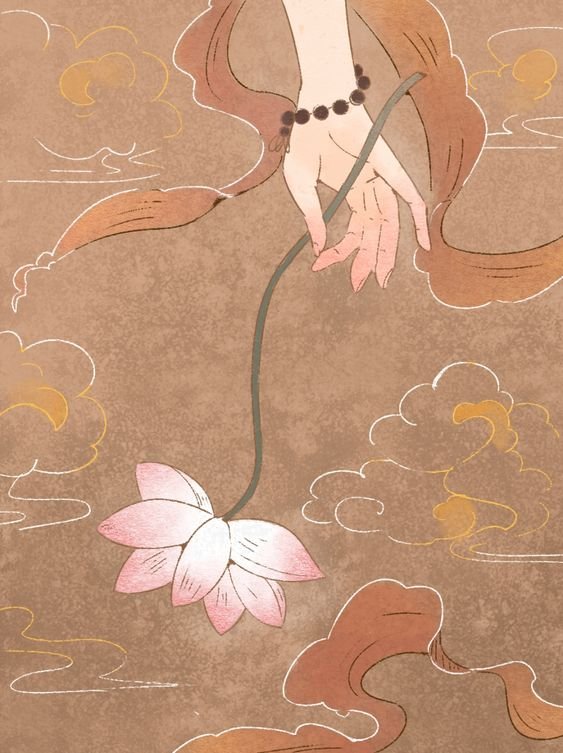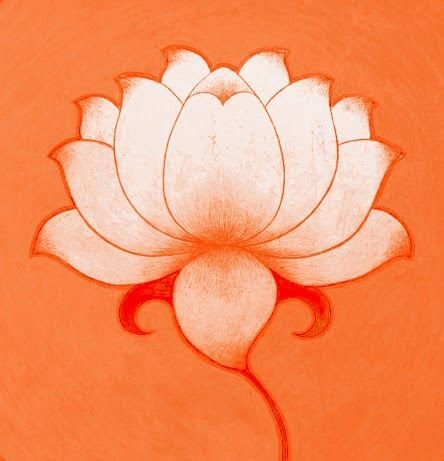Decoding Symbols of Hinduism: Lotus (Padma)

The Lotus flower also known as the sacred lotus is an aquatic plant species that grows in murky, dirty conditions. Despite of being rooted in the mud, it petals bloom stainless and often this quality of the flower is associated with the aspect of purity. Furthermore, the flower’s act of blooming at dawn and closing itself back into the dirty waters is said to symbolize rebirth, resilience and strength. Lotus is found across India, Southeast Asia and East Africa, and has different meanings across cultures. The flower appears in the ancient world, holding a position of importance in the art, architecture and cultures of the old, as well as serves as a prominent symbol in ancient religions of the world.

In ancient Egypt the white and blue lotus were considered to be of importance. The Egyptian white lotus and the Egyptian blue lotus were part of the art and architecture of the ancient Egypt. The lotus was carved into temples, often carved as the temple bases as a representation of the Gods, namely Hapy the Nile God. In other depictions, the lotus can be seen held by a god. In ancient Egypt the flower was seen as a symbol of Upper Egypt. Lotus and the papyrus flower was depicted in the Egyptian tombs and temples and served as a symbol of the unification of the Upper and Lower Egypt. The Upper and Lower Egypt or The Two Lands is said to be the final stage of the prehistoric Egypt. The ancient Egypt was divided into two regions. To the north was the Lower Egypt and to the south was the Upper Egypt. This unification of the two realms was often depicted with the lotus also called as the water lily and the papyrus plant, representing the Upper and Lower Egypt.
The ancient Egyptian also believed that at the beginning, before there was creation, the earth was a watery chaos, and from these waters a lotus flower emerged, and from between the bloomed petals the sun god appeared. This myth derives itself from the Lotus’s act of blooming during the dawn and closing itself at evenings. The ancient Egyptians associated this natural course of the flowers action to notions of rebirth and restoration, and saw it as a symbol of the Sun; as the sun rises in the morning and sets in the evening. The myth further states that the Sun god was attacked nightly by the giant serpent Apophis, whose aim, was to prevent the sun from rising which could result in the destruction of life on earth. Thus, the lotus also symbolises strength and resilience.

Similarly, the lotus flower is seen as a significant symbol in Hinduism. The lotus is mentioned in ancient Hindu texts such as the Rigveda, and is used to describe the birth of the god Agni. Agni is said to be one of the most worshiped gods of the Rigveda scripture besides Indra, the thunder god. Thus, in the Vedic scripture the lotus is linked to birth and divinity. On the other hand, the goddess Lakshmi is associated with the flower. She is also called by names such as Padma, Kamala and Ambuja which all mean the flower lotus. In most of her iconography the goddess is depicted as being seated on a fully bloomed lotus, and holding the flower in her hand. The goddess is associated with prosperity, fertility, beauty and spirituality. It is believed in Hinduism that every person is born with a lotus in his or her heart, and that a person can attain true spirituality once they surpass and grow beyond the material wealth and become one with divinity. In this manner, the flower in relation to Lakshmi symbolises transcending above the material wealth of the world to higher level of spirituality. This association highlights the idea that material wealth, when attained and used with purity of heart and intention, can lead to spiritual prosperity and fulfilment.

Furthermore, in Hinduism the lotus flower also symbolises fertility and the cycle of creation. The flowers ability to grow from the murky depths of waters and rise above the water to bloom represents the journey of life emerging from the depths of existence into the light of consciousness. The symbolism ties with the Hindu belief in the cyclical nature of life, death and rebirth. The cyclical nature of life is a fundamental concept in Hindu philosophy. It is expressed through ideas like reincarnation where souls are believed to undergo a continuous cycle of birth, death, and rebirth. The lotus flower thus is a reminder of growth, renewal and regeneration, as the flower continues to rise from the dirty water, blooming and retreating as a reflection of the cyclical nature of life.

The lotus is also a symbol of creation and is depicted in the iconography of the creator deities like Lord Vishnu and Lord Brahma. The flower is said to emanate the energy of creation from the union of Vishnu and Lakshmi who is believed to be the wife of Lord Vishnu. The flower often emerging from his navel, Vishnu is also called Padmanbh. Its unfolding petals represent the emergence of the universe from the divine source, signifying the process of creation and manifestation. The lotus flower which grows in the muddy waters remains untouched by the impurities and therefore is seen as a symbol of Vishnu as the preserver of the universe, as he remains untouched by the illusions of the world and maintains a state of purity. The lotus in his hand symbolises the highest spiritual experience that can be achieved from Yoga.

According to the Puranas, Lord Brahma the creator of the universe was a self born from a lotus flower that grew from Lord Vishnu’s navel. He is often depicted seated on a lotus emerging from Vishnu’s navel and lies in the cosmic waters. Brahma in some Hindu iconography is sometimes seen holding a lotus in his hand. This holding of lotus is symbolic of his creative power and role in bringing forth life and consciousness to the universe, because the lotus is commonly believed to serve as a reminder of spiritual growth and enlightenment that is inherent in creation. The lotus’s symbolism of purity, beauty, rebirth and cyclical nature of life also connects the flower to Lord Brahma, who initiated the creation of the universe and also urges the believers to connect themselves with the cosmic nature of the universe.
This embedded history and religious belief in the lotus flower is therefore also a major reason behind it being labelled as the National Flower of India. Due to its rich cultural significance both in mythology and art, the flower holds an important position as a cultural identity of India. After India gained its independence from the British rule, many Indians suffered from a loss of identity. They were in a kind of a limbo between two cultural identities, that of an Indian identity and of the western ideas and thoughts that were imposed by the British Raj. Thus, this dire need and urgency to reclaim the Indian identity led many Indians back to ancient Indian texts and history.

The lotus flower also is a major symbol in Buddhism. The growing of the flower is related to the rise of Buddha from this world, unstained by the impurities of desire, and represents the purity of the body, speech and mind. The traditional texts of Buddhism say that Buddha’s first seven steps lead to the appearance of the lotus flower, turning into lotus thrones as a pedestal upon which Buddha is seated and other important figures of Buddhism; signifying the transcendent wisdom and purity of Buddha and other Buddhist figures. The flowers unfolding petals symbolize the gradual opening of the heart and mind to the teaching of Buddhism, leading one to enlightenment. The stages in which the lotus grows that are the seed, bud and the blossomed flower in Buddhism symbolizes various stages of spiritual development, from awakening to enlightenment.

The lotus flower is depicted as a significant symbol across various cultures and ancient religions. The flower’s essence of purity, spirituality, beauty, rebirth and regeneration has prevailed and lasted from the times of ancient Egyptian up until the twenty-first century. In today’s time the flower can be viewed as a life philosophy of never giving up and resilience in face of adversity; and to thrive despite of how dark and murky life can get.


